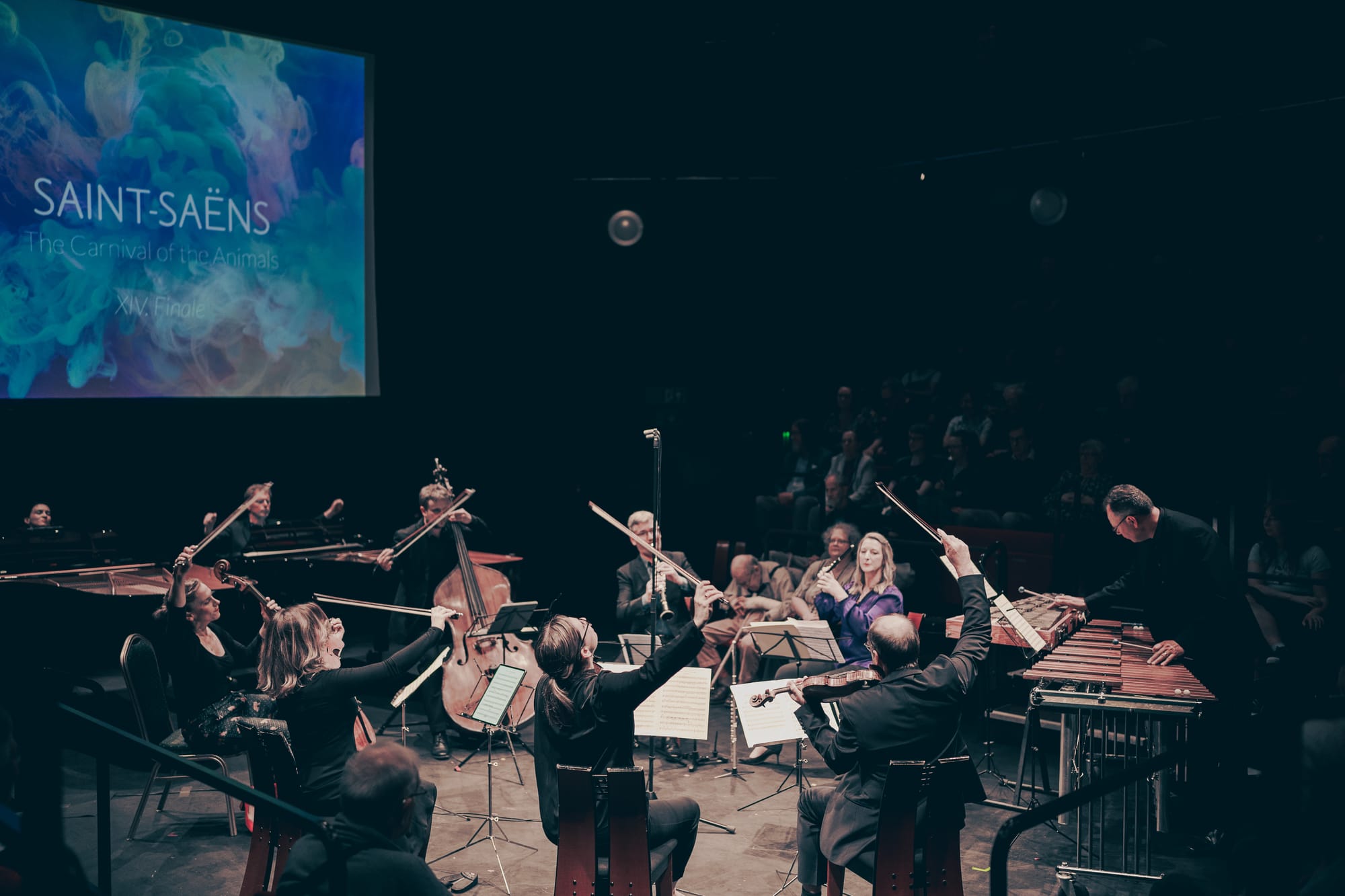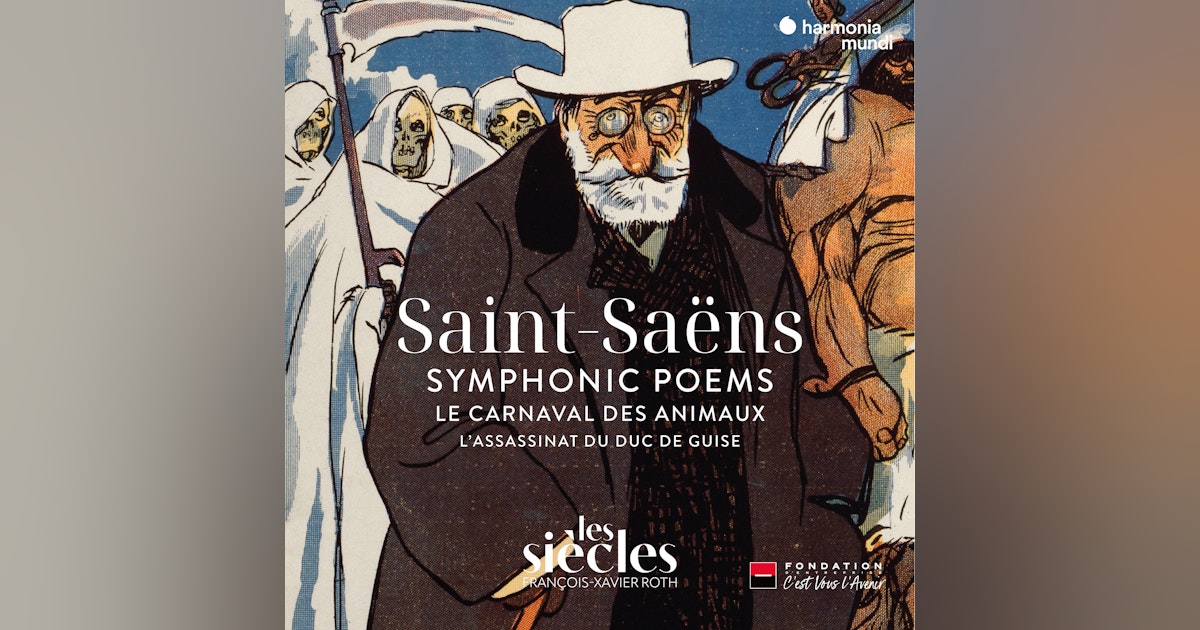
Music In The Round: Saint-Saëns; The Renaissance Man Ensemble 360 / George Morton (conductor, L’assassinat du duc de Guise). Crucible Playhouse, 21.05.2024
Morceau de concert in F minor, Op. 94 / R 203 (1887)
Bassoon Sonata in G major, Op. 168 / R 148 (1921)
Les odeurs de Paris, ‘Grande Marche’ (1870)
L’assassinat du duc de Guise (1908)
The Carnival of the Animals (1886)
Sheffield’s Music in the Round celebrates 40 years this year (1984-2024); Steven Isserlis is Guest Curator this year, and has designed a mouth-watering sequence of concerts. It was the idea of a rare performance with film of Saint-Saëns’ L’assassinat du duc de Guise that was the main pull for this writer, but as it turned out, delights and discoveries abounded at every turn; a similar sense of infinite possibility occurred two years ago (report).
Ensemble 360 showed itself to be an ensemble of the highest rank; they need to be, to tackle the often difficult music of Saint-Saëns. As Isserlis says, this composer is
… a marvel in every way: poet, playwright, philosopher, astronomer, classical scholar, animal rights activist, and so on – the list is endless, and this is in addition to being a master pianist, organist, conductor – and, of course, composer.
For all the pull of the film, though, here was much of note in the pieces in the first half of the concert, beginning with the Morceau de concert in F minor, brilliantly played by horn player Naomi Atherton with the ever-sensitive pianist Tim Horton. The piece itself is essentially a theme and variations, allowing for both long-breathed melodies and virtuosity. And so it was on this occasion, Atherton’s super-clean slurs particularly impressive. The piece is vivacious, particularly in its latter stages, and how wonderful to hear it in such a swashbuckling performance as this.
It’s a great piece, and here is an alternative masterly performance, this time with orchestra: Hermann Baumann with the Leipzig Gewandhaus Orchestra and Kurt Masur:
The late Bassoon Sonata was new to me. In his final years, Saint-Saëns wrote three works for wind, sonatas for oboe, clarinet and bassoon (the bassoon was the last to be written); more were planned (flute, cor anglais) but sadly did not come to fruition. The Bassoon Sonata, written at the grand old age of 85, breathes serenity and complete command. Looking at the date of composition (1921), this might seem conservative, but how the music stands perfectly on its own two feet. Melodies seem divinely inspired. The first movement, an Allegro moderato, begins in almost Impressionist fashion. Bassonist Ursula Leveaux has a lovely sound, and offers complete clarity in the melodic decorations. An Allegro scherzando is terrific fun, Horton completely alive to the rhythms and dialogues, Leveaux as agile as can be. It was the sheer grace of the Molto Adagio finale that was so impressive here, Levaux’s smooth legato set against Horton’s staccato. The piece ends with an Allegro moderato section, relatively slight in duration but here absolutely gorgeous and alive. The performance was given in the complete belief in the composer’s genius, and how beautiful it was.
Here’s a performance with score from 1976 with Maurice Allard and Annie d’Arco:
Finally for the first half, a piece probably from 1870, a ‘grande marche‘ entitled Les odeurs de Paris, scored for children’s orchestra (bird whistles, flageolets and so on, with piano, strings, trumpet and harp. This is short and to the point, and yes a lot of fun; but even here there are some truly beautiful harmonic progressions
And so to the film, L’assassinat du duc de Guise, twenty extraordinary minutes of filmic entertainment that carried the first original film score by a major composer. Written by Henri Lavedan and directed by Charles le Bardy and Andrê Calmettes, it was first shown in Paris in 1908. Apparently composed scene by scene in front of the screen, it shows an extraordinary light touch and sensitivity to the ongoing (somewhat hammy to contemporary eyes) action. George Morton directed a performance that was of split-second accuracy. For all the drama, Saint-Saëns ensures there is a thread of lyricism through the whole. The scoring included harmonium, which added a very characteristic timbre to proceedings. This was a once-in-a-lifetime opportunity to see this expertly crafted little gem …
Here’s a YouTube of the film, with Saint-Saëns’ music:
… and so to the Carnival of the Animals, that ‘grand zoological fantasy’ that never fails to please. The piece also gives opportunities for each member to shine, and one heard Ensemble 360 as a collective of equal talents. Philip Nelson was the characterful double-bassist/Elephant, while Horton and co-pianist Ivana Gavric were equally fleet of finger. A magnificent performance: perhaps ‘Aquarium’ was the highpoint, a celebration of beauty in sound, while cellist Gemma Rosefield delivered a phenomenal ‘Swan’.
A powerful reminder of the stature of Saint-Saëns, then. The Sheffield Chamber Music Festival continues to delight and stimulate.
There is a fine set on Harmonia Mundi (conducted by the ever-refreshing François-Xavier Roth) that includes both Carnaval and the music for the film, available at Amazon here.










